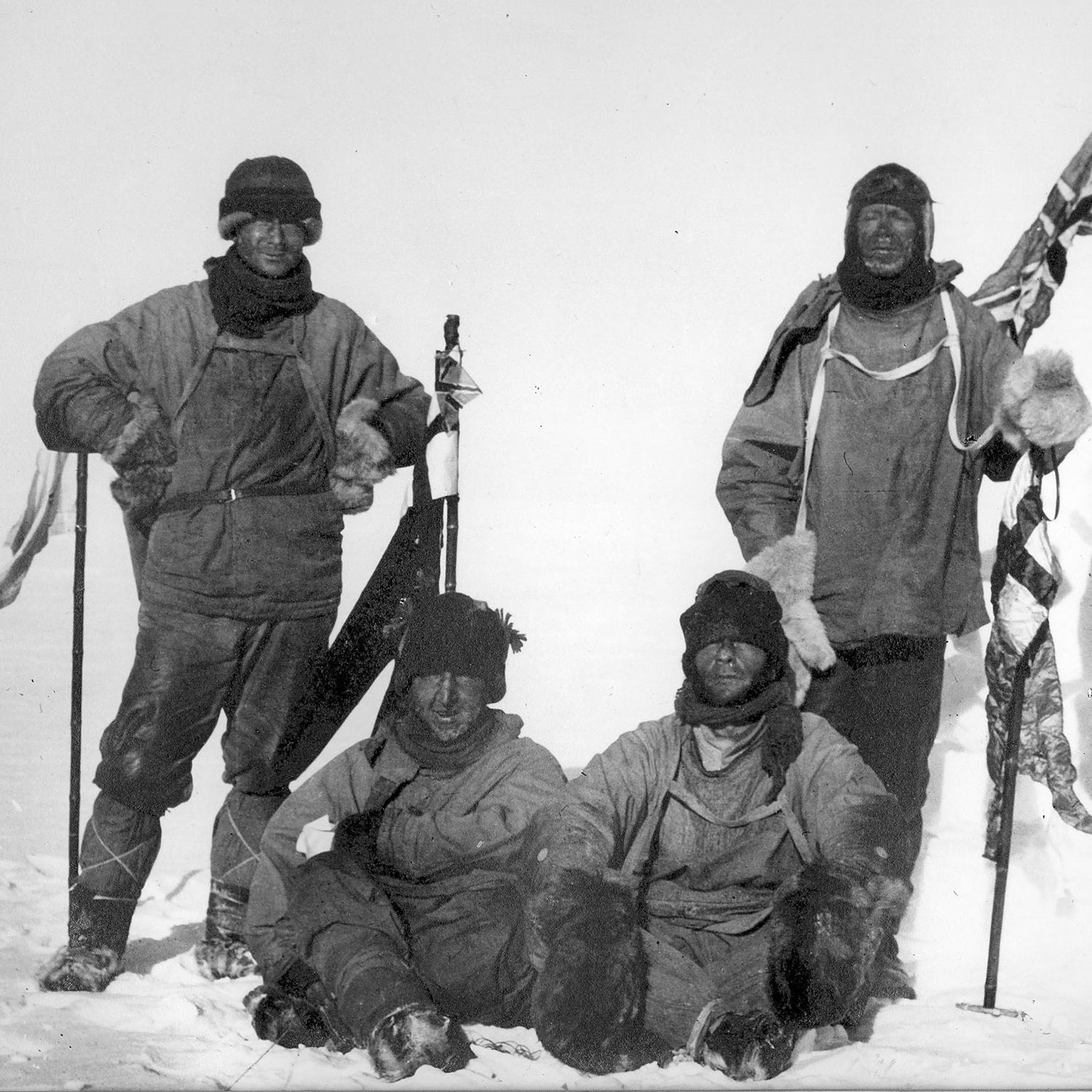On March 29, 1912, Captain Robert Falcon Scott lay in his tent during an Antarctic blizzard and wrote his last diary entry. It had been two months and 11 days since he and his four men reached the South Pole, only to realize that a Norwegian team, led by Roald Amundsen, had beaten them there by a month.
Scott’s team began their 800-mile slog on January 19. It went badly. One of the expedition members died in his sleep—apparently overwhelmed by frostbite, exhaustion, and despair—in mid-February. A second member, sick and injured, walked out into a blizzard a month later, never to be seen again, hoping to spare the group the burden of caring for him. The three survivors struggled on, but as of March 21, they were pinned down in their tent by the weather, steadily running out of food and fuel. They were just 11 miles from their next supply cache, but it might as well have been 1,100. They couldn’t move.
“�����ԹϺ��� the door of the tent it remains a scene of whirling drift,” Scott wrote in that last entry. “I do not think we can hope for better things now. We shall stick it out to the end, but we are getting weaker, of course, and the end cannot be far. It seems a pity, but I do not think I can write more.” A search party found Scott and his companions frozen in their sleeping bags eight months later.
In the 105 years since their bodies were discovered, the story of Scott’s death has been told and retold. His diary was first published in 1913 and remains in print. , a book published in 1922 by Apsley Cherry-Garrard, one of the expedition survivors back at base camp, became an adventure classic. Dozens of biographies and historical narratives have been published, and academics have pored over every detail of the expedition from beginning to end, trying to understand what went wrong. Scott has been painted as the noblest of heroes and as a bungling incompetent.
Now, a new academic article published in the Polar Record suggests that Scott’s chances of success—and survival—may actually have been undermined by one of his own men.
Chris Turney is a professor of earth sciences and climate change at the University of New South Wales in Sydney, Australia. He’s done some remote and rugged Antarctic travel himself on various field research expeditions. Turney’s ship was once ensnared in sea ice for a week, giving him a taste of what others—most notably, Ernest Shackleton—had gone through during their polar expeditions. His initial interest in Scott was focused on the expedition’s scientific work. Antarctica has a short and patchy record of weather and climate observations, and the records compiled by Scott and others, Turney says, “are like gold dust” for people like him.
Evans, it seems clear from various diaries and letters, was not well-liked by his teammates on the expedition.
But despite himself, Turney was eventually drawn into the arguments around Scott’s fate. He began to suspect that he’d stumbled onto an untold facet of the story a few years ago, when he was researching his book, . He’d been digging around in old documents and began to wonder about the role of Lieutenant Edward “Teddy” Evans, Scott’s second in command. (Teddy should not be confused with Edgar Evans, who died in his sleep on the return from the pole.) That led to more research, which resulted in the scholarly article he published in the Polar Record last September, “”
In it, Turney argues that Evans may have compromised Scott’s safety on two fronts: first, by taking more than his fair share of food from the expedition’s caches, and second, by muddling or failing to deliver some of Scott’s final orders regarding the sled dogs at base camp.
Understanding Turney’s arguments requires a quick crash course on the expedition, officially known as the British Antarctic Expedition. Think of old-school, siege-style mountaineering: climbers assaulted mountains systematically, with large teams, building camps and caches as they went.
That’s how Scott tackled the attempt on the South Pole. He arrived on the ice late in 1910 and spent the early part of 1911 establishing his first supply depots before settling into his base camp for the Antarctic winter. He finally headed for the pole in the fall of 1911 with ponies, dog teams, and experimental motor sledges, in addition to his team of more than a dozen men. They slowly worked their way south, building a series of caches along the way for their return. The sledges broke down, the ponies died, and eventually Scott sent the dogs and some of the supporting team members back to base camp, leaving the remaining men to haul their supplies themselves.
On January 4, 1912, as they neared the pole, Scott sent Teddy Evans and two others—dubbed the Last Supporting Party—back the way they had come along the chain of supply depots, while he and four others, the Polar Party, carried on to the South Pole.
That’s where Turney’s research comes in. Evans, it seems clear from various diaries and letters, was not well-liked by his teammates on the expedition. He was angry that he’d been left out of the Polar Party and angry that he was being sent back with just two men while Scott carried on with four. On his doomed trek back from the pole, Scott found unexpected shortages of food in the supply depots; Turney argues that Evans, disgruntled during his own return voyage, took more than his share. On the way back, Evans got sick with scurvy—unlike the rest of the men, he refused to eat the seal meat that helped stave it off. Later, back in London as the Scott disaster was being unraveled, the taking of the food was excused as the act of a sick man saving his own life. Turney argues, however, that Evans fudged the timeline of his illness to avoid blame. A letter written by Evans dated from 1912 has him getting sick with 300 miles to go, but Evans later claimed to have gotten sick with 500 miles to go.
Further, Turney suggests that when the others eventually dragged Evans into base camp, in late February, he failed to convey an order from Scott. The order, noted in a sketchbook retrieved from one of Scott’s two dead companions, asked that the dog teams be sent out to help retrieve the Polar Party. (Apsley Cherry-Garrard would lead the dogs out in early March, but only as far as One Ton Depot, which Scott never made it to.) Still sick, Evans boarded a ship for New Zealand on March 4, 1912. Other members of the team remained at base camp, waiting for Scott and the rest to arrive.
“I don’t think he thought that Scott would die,” Turney says of Evans’ actions. “It’s more incompetence rather than anything else, [and] probably a little bit of anger. But I don’t think it’s something where he went out of his way to cause death at all.”
Turney, having spent time on the ice, is somewhat more sympathetic than other armchair Scott-watchers might be to the pressures Evans was under. He understands the stakes better than most. “We all make mistakes, and, of course, individually they don’t really amount to much,” he told me. “But when you have two or three—which is what Evans seems to have done—in an environment like that, small errors blow out massively and end up having a cascade effect, and that was very true in this situation. And then he massively covered things up afterwards by the looks of it.”
Someone who is randomly struck by lightning and killed is a sad case. Someone who is struck while studying lightning, chasing it, seeking it out, is something more complicated and compelling to the public.
Turney’s article has already generated reactions from the devoted community of historians and history buffs who have followed Scott’s story. “Even a century after it happened, people have very strong views,” Turney says. Some of the people he’s heard from are “quite cross about it.” But he’s also been in touch with the descendants of some expedition members. Family members of Cherry-Garrard, who lived out his life wondering if there was more he could have done to save Scott and the others, told Turney that their ancestor would feel “vindicated” if he were still here.
Karen May, a researcher whose 2012 Polar Record article “” helped reshape our understanding of Scott’s fate by poking holes in a book that had positioned him as incompetent, is critical of the new assertions from Turney. In her view he “makes the mistake of arguing from ‘character’ rather than ‘actions,’” she told me in an email. That is, in emphasizing Evans’ unpopularity and unsuitability as a member of the team, Turney prepares the reader to expect the worst from Evans and to see his subsequent choices in that light.
The confusion surrounding the order for the dog teams, May says, stems from Turney assigning a date of 1912 to an undated document that she argues, convincingly, is actually from 1911. (For instance, it uses the future tense, May says, and is written in ink, not pencil, as all the 1912 writings were, because ink freezes when you’re living in a tent on a glacier.) If true, that would mean there were no updated orders for Evans to pass on, as Scott’s orders regarding the dogs remained unchanged.
As for the food, May disagrees with Turney’s interpretation that Evans began taking extra food before he got sick and then fudged the timeline later. The discrepancies, she says, “can be explained by Evans not wishing to disclose his scurvy to his naval subordinates, and instead keeping it firmly to himself until it could no longer be hidden.” In other words: May thinks it’s more likely that a person in Evans’ situation might hide the extent of his sickness from his team for awhile, trying to tough it out, while sneaking a little extra food to survive.
Both Turney’s work and May’s have focused on the external factors that might have allowed Scott to make it home. But in the end, May points out, his fate was a kind of choice. “We need to put all this in perspective and remember that Scott—had he been the ruthless type—could have left his debilitated men behind to die, taken their food, and got himself to safety,” she wrote to me. Instead, Scott urged them on until they couldn’t go any farther, losing time and his own life in the process. It was that discipline, in part, that made him a national hero in his era and a target for skeptics later on.
It’s that tragic element that keeps people in thrall to Scott’s story more than a century after his death. Someone who is randomly struck by lightning and killed is a sad case. Someone who is struck while studying lightning, chasing it, seeking it out, is something more complicated and compelling to the public.
One thing is certain: Turney’s article won’t be the last reassessment of Scott, his teammates, or their fate. While government documents are public, there may still be private letters, diaries, and reminiscences from expedition members that have yet to be discovered and examined by Scott scholars and could shed new light on what went wrong. “A lot of the documents are still held by families,” Turney says. “It does make you wonder what else is out there.”


